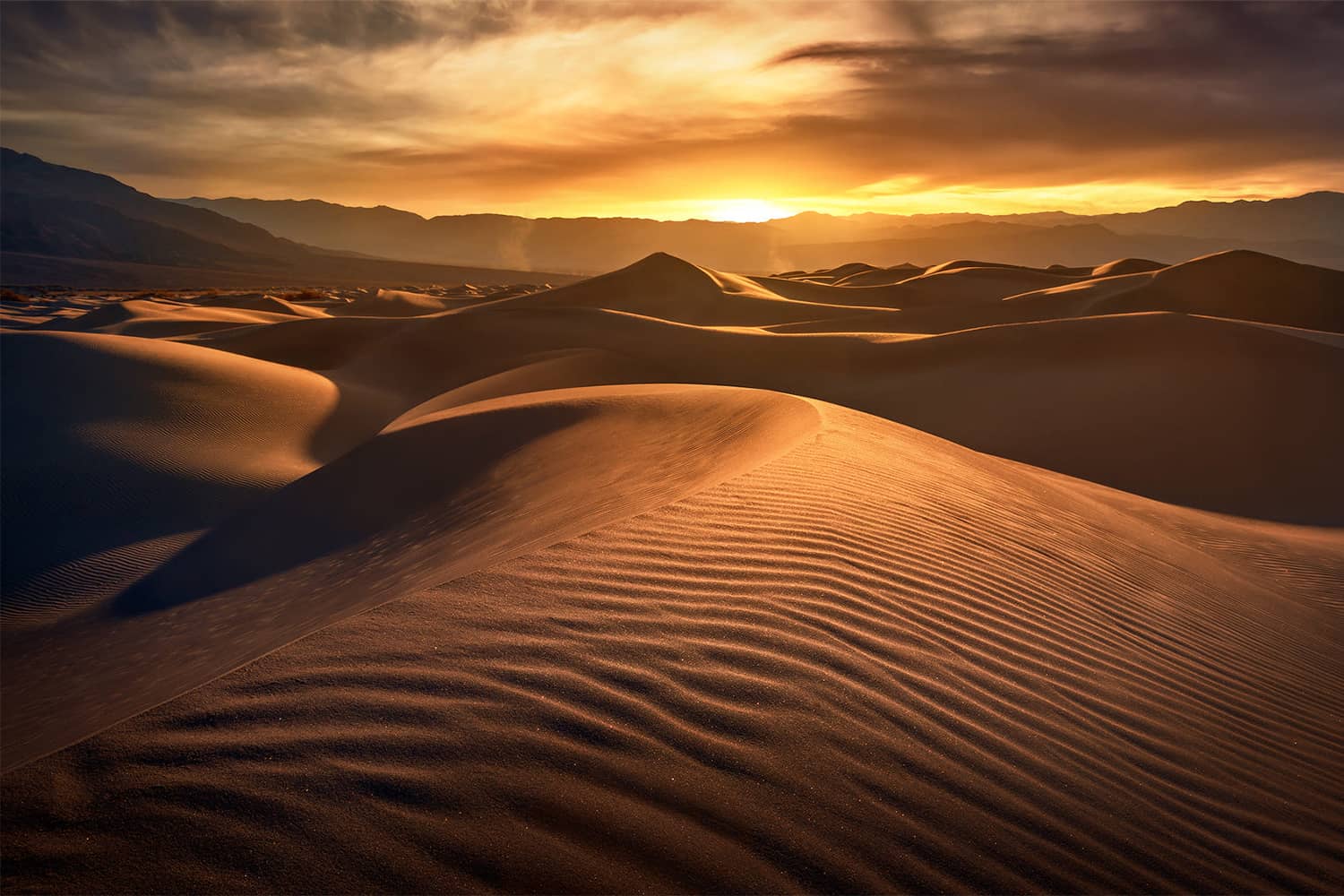SURVIVAL IN SANDS
Search drinking water in the desert
The main thing In the desert is not to get lost if you don’t have an adequate supply of water with you. If this happens, take all possible measures to maintain the degree of hydration of the body until you find new sources of water. Remain fully clothed when traveling in dry areas during the day. When the wind blows over your sweaty clothes, it will create a cooling effect. The best option is to rest during the day and make transitions at night, when the likelihood of sweating and thus losing valuable fluid is reduced. If you run out of water, do not eat anything. Digestion of food will lead to the expenditure of the remaining body fluid.
If the terrain permits, climb higher ground before looking for cover for the day. Look for signs that indicate the presence of water sources nearby. From a higher point, it will be easier for you to see if there are vegetation and animals in the area. Look for signs of life at ground level as well. Remove the topsoil. In dry river beds can be hidden reserves for replenishing water deficit in the body in the form of wet sand. If you don’t find anything after making a 30-centimeter dimple, try digging a few holes elsewhere.
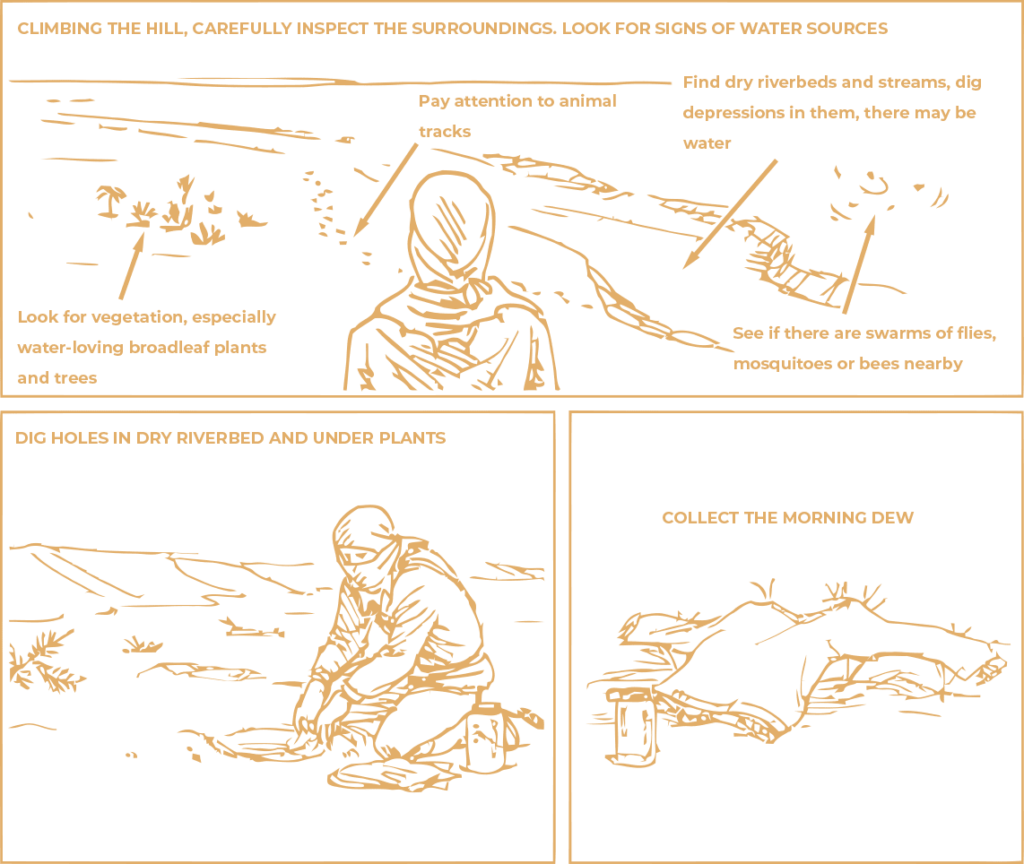
Even the bed of a long-dry river can retain some moisture after a recent rain. Collect the dew. This is the last option and should only be used as a last resort. Donate night time travel. Spread out your clothes overnight, and then squeeze out any dew that will fall out during the night and in the morning. In this way, you can collect about half a liter of dew from each square meter.
Making fire with sunlight
The main natural resource of the desert is bright sunlight. However, after sunset, due to the lack of cloud cover, the earth quickly gives away the received heat. Desert temperatures can drop dramatically. Therefore, if you are not walking the route at night, you need a heat source to keep you warm.
To do this, even in the daytime, use bright sunlight to light a fire with it. All you need to do this is a clear plastic or glass bottle with a little water or other liquid and a few sheets of newspaper. Use the convex end of the bottle to refract or change the direction of the sun’s rays. Passing light through your homemade lens, the rays can be focused at one point, where the energy will be concentrated, leading to heating.
If the glass itself is thick enough to refract sunlight, then you can do without liquid.
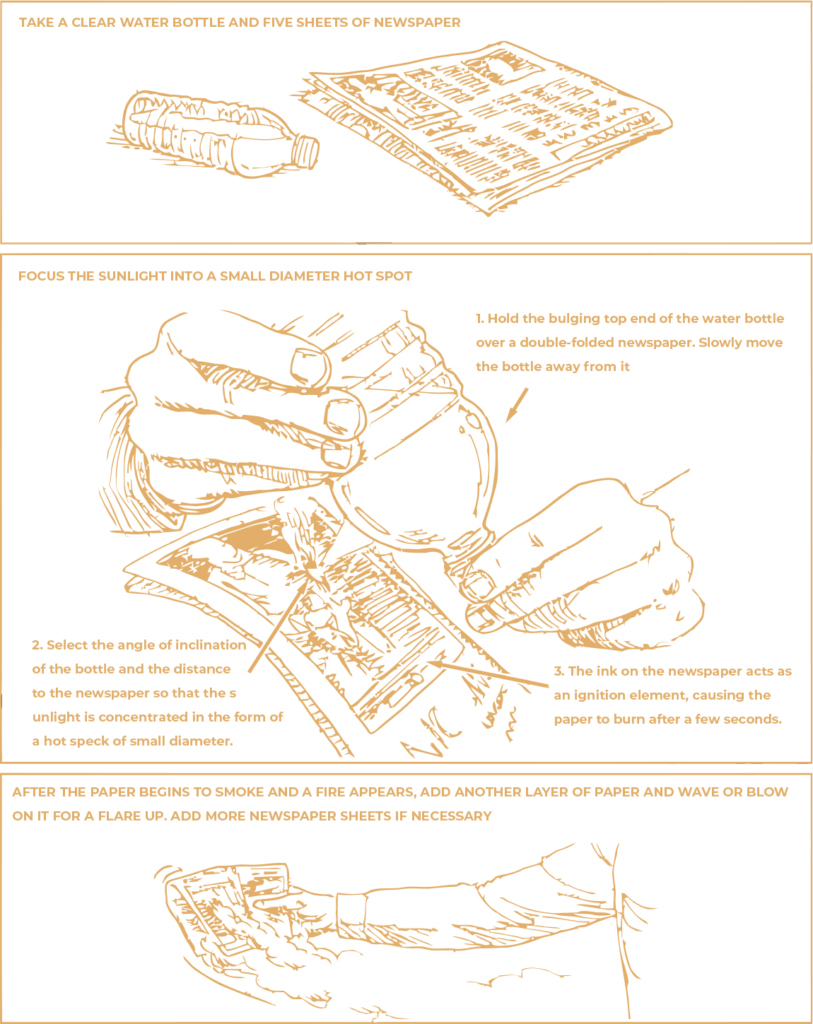
This device can increase the power of sunlight to such an extent that the newspaper turns red and then begins to smoke. However, the intensity of the sun’s rays is highly dependent on the time of day and season. Dark ink on paper will act as a flammable substance. Instead of newspaper sheets, you can use dried leaves and grass, or pieces of dry branches. In most deserts, you will find a lot of flammable brushwood. Shake the kindle under the lens a little to create a flame instead of smoke.
Finding the eat and cooking in the desert
When crossing a desert area, fight the urge to pounce on the first vegetation you encounter. Some of its varieties, such as candelabra euphorbia or datura, when consumed, cause severe vomiting and hallucinations. Try to find safe edible plants that are common in all parts of the deserts of North America. These are chia, or Spanish sage, opuntia cactus and purple ferocactus.
The North American Indians and Aztecs were the first to learn about the beneficial medicinal properties of chia. Place this bright purple flower in a container and shake it to spill out the seeds, which are very rich in nutrients. They can be eaten raw or soaked in water for what looks like a pudding. When removing the thorns from the plates of the opuntia cactus, also known in Latin American cooking as nopalito, do not injure your hands. You can do it easier: scorch these plates so that the thorns burn out. And if we talk about purple ferocactus, avoid drinking the juice contained in its trunk: the pulp of this plant is edible, and the liquid can cause diarrhea and dehydration.
Lizards follow ants, and snakes follow lizards: they can all serve as food for you.
To catch the snake, find a long stick with a fork at the end and have a sharp knife ready. With a horn, press down the snake’s head. The other hand, moving it along the back closer to the head, grab the reptile by the jaws and force it to squeeze them.
The snake’s body can wriggle around a stick or hand, but this is not scary: at this stage, the main thing is not to let go of the head.
Drop the stick and, while still holding the snake’s jaws closed, with your free hand, cut off its head with a knife.
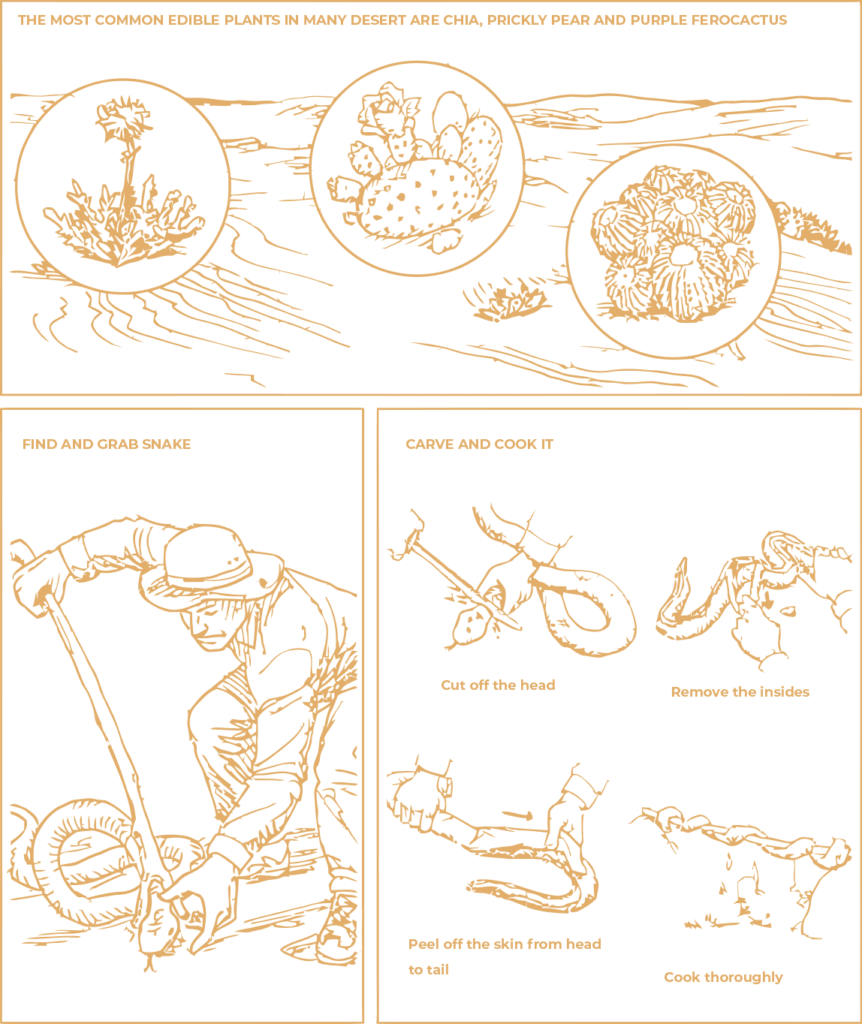
Then, at a distance of about 10 cm from the head, cut off the torso. Thus, you will surely get rid of the poisonous glands that the snake has. The head must be thrown as far as possible: even after death, impulses in its nerve endings for an hour can lead to a pronounced biting reflex. Although it is usually possible to tell if a reptile is poisonous by the presence of rhombus on its head, it is safer to assume that any snake you meet is dangerous. It should be borne in mind that she can throw herself from a distance equal to half the length of her body, and therefore you need to approach her with caution.
Construction to shelter from the heat in the desert
Surviving the desert try to conserve energy all the time. If you come across a ready-made shelter, you can consider it a great success: you don’t have to spend a lot of precious kilocalories to create it. Therefore, try to find a natural refuge first. In the desert, moisture protection is usually not a problem, and therefore will be sufficient if the shelter found provides you with only shadow, and is not completely closed. A place among the rocks with a cool breeze blowing is fine.
You can build an effective shelter right in the sand with just two cloaks or tarps and a shovel.
If you prevent the sun’s rays from entering the shelter with the help of cloaks or tarps, then even the warmest wind can blow heat out of it even before it heats up the shaded part.
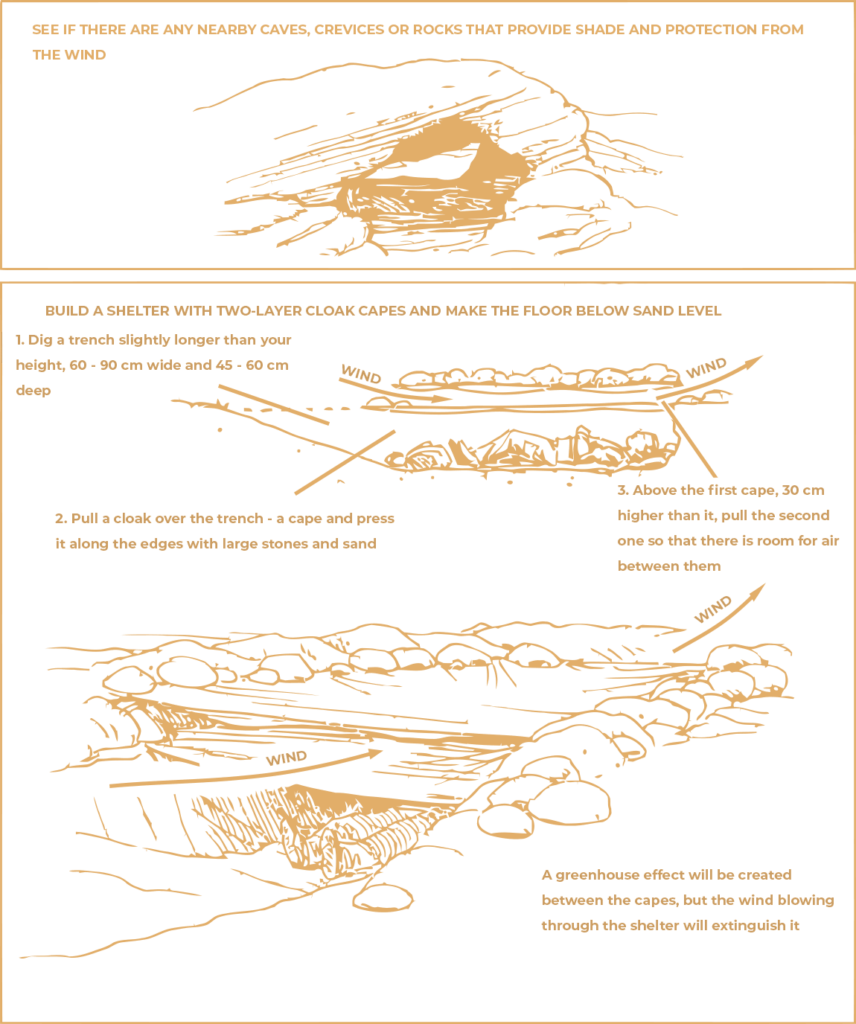
Such a shelter avoids the greenhouse effect that usually manifests itself in enclosed spaces. A tarp, even on a dry and windless day, will prevent UV rays from entering your shelter, making it much cooler inside than outside. The temperature can be lowered a few more degrees by removing a 60-centimeter layer of sand hot from the sun under the awning. And if you make the open entrance to the shelter sloped, the air will wrap around your body. To do this, the dug trench must be oriented parallel to the direction of the wind, and the entrance, open with a slope, must be made in the direction from which the wind is blowing.

